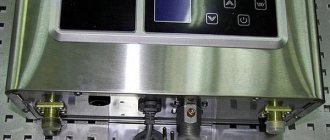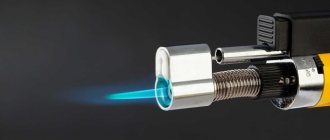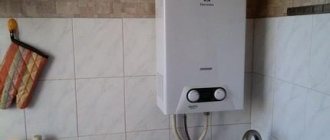Like any other mechanism, the water block has wear parts in its design. When they become unusable, the operation of the heater deteriorates or stops altogether. Common situation?
If a malfunction occurs, a home craftsman is quite capable of repairing the water unit of a geyser on his own by disassembling the gearbox and replacing used consumables. To begin with, we suggest you figure out how to disassemble and repair the water unit of an instantaneous water heater yourself. The information will also be useful when performing preventive examinations. We will provide the presented material with thematic photos and video materials.
How to change the membrane in a geyser Neva
Yuri Makarov, personal archive
Gas water heaters Neva 3208 (and similar models without automatic water temperature control L-3, VPG-1820, VPG-23, Neva 3210, Neva 3212, Neva 3216, Darina 3010) are often found in houses without centralized hot water supply. This speaker has a simple design and is therefore very reliable. But sometimes she also brings surprises. Today we will tell you what to do if the hot water pressure suddenly becomes too weak.
Geyser Neva 3208 , or more precisely, a wall-mounted instantaneous gas water heater, is a device for producing hot water using the energy of combustion of natural gas. The geyser is an unpretentious thing and easy to use. Of course, according to the idea of public utilities, centralized supply of hot water is more convenient, but in practice it is still unknown which is better. The hot water coming out of the pipe is either rusty or barely warm, and the fees are steep. And the notorious summer blackouts, during which owners of gas water heaters smile and listen to stories about heating water in a basin on the stove, are not worth mentioning.
Fault diagnosis
So, one morning the water heater turned on properly, but the water pressure from the hot water tap in the bath seemed too weak . And when the shower was turned on, the column went out completely. Meanwhile, the cold water was still flowing vigorously. Suspicion first fell on the mixer, but the same situation was discovered in the kitchen. There is no doubt left - the problem is in the gas water heater. Old lady Neva 3208 presented a surprise.
Attempts to call a repairman for repairs ended, essentially, in failure. All the technicians directly over the phone “diagnosed” in absentia that the heat exchanger was clogged with scale and offered to either replace it (2500-3000 rubles for a new one, 1500 rubles for a repaired one, not counting the cost of work), or wash it on site (700-1000 rubles. ). And only on these conditions did they agree to the visit. But it didn’t look like a clogged heat exchanger at all. The night before, the pressure was normal and scale could not build up overnight. Therefore, it was decided to carry out the repairs ourselves. By the way, it is also possible to carry out repairs if the dispenser does not turn on at normal pressure - most likely, the membrane in the water unit has broken and needs to be replaced.
Gas water heater repair
The Neva 3208 geyser is installed on the wall of the kitchen or, less commonly, the bathroom.
Before starting repairs, you must turn off the column, shut off the gas and cold water supplies.
To remove the casing, you must first remove the round flame control knob. It is fixed on the rod with a spring and can be removed by simply pulling it towards itself; there are no fasteners. The gas safety valve button and plastic trim remain in place and do not interfere. Removing the handle gives access to two mounting screws.
In addition to the screws, the casing is held on by four pins located at the top and bottom at the rear. After unscrewing the screws, the lower part of the casing is pulled forward by 4-5 cm (the lower pins are released) and the entire casing goes down (the upper pins are released). Before us is the internal structure of a gas water heater.
Our problem is in the lower, so-called “water” part of the column. This part is sometimes called the "frog". The functions of the water unit include turning the column on and off depending on the presence or absence of water flow. The operating principle is based on the properties of the Venturi nozzle.
The water unit is secured with two union nuts to the water supply pipes and three screws to the gas part.
But before removing the water unit, you need to take care of the water in the column. As a last resort, you can place a wide basin under the column during disassembly. But you can drain the water more carefully through the plug located at the bottom of the water unit.
To do this, unscrew the plug and open any hot water tap after the column to allow air to enter. About half a liter of water is poured out.
By the way, you can try to flush out the blockage through this plug without removing the water unit. This is done with a reverse flow of water. With the plug removed (don't forget to place a bucket or basin) in the faucet in the kitchen or bathroom, open both taps and clamp the spout. The cold water will flow back through the hot water pipes and possibly push out the clog.
After draining the water, the water assembly can be removed without danger. We unscrew the union nuts, move the tubes slightly to the sides, loosen the three screws on the gas part and remove the assembly down.
By the way, under the left nut in the recess of the water unit there is a filter in the form of a piece of brass mesh. It needs to be pulled out with a needle and cleaned well. When I removed this filter, it fell into pieces due to age. Considering that the apartment already has a pre-cleaning mesh filter after the riser, and the pipes are metal-plastic, it was decided not to bother with a new one. If the pipes are steel or there is no filter on the riser, then the filter at the inlet to the water unit must be left, otherwise the column will have to be cleaned almost monthly. A new filter can be made from a piece of copper or brass mesh.
The water assembly cover is held in place by eight screws. In old designs, the body was made of silumin, and the screws were steel; unscrewing them was often very difficult. The Neva 3208 has a brass body and screws. After removing the cover you can see the membrane .
In older models, the membrane was flat rubber, so it worked in tension and tore quite quickly. Replacing the membrane every one to two years was routine. In Neva 3208 the membrane is silicone and profiled. It hardly stretches during operation and lasts much longer. But in case of problems, replacing the membrane is quite simple, the main thing is to find a high-quality silicone one. And finally, under the membrane is the cavity of the water unit.
Several small specks were found in it. But the main problem was in the right output channel . There is a narrow nozzle (about 3 mm), which creates a pressure difference for the operation of the water unit. It was this that was almost completely blocked by a very firmly stuck flake of rust. It is better to clean the nozzle with a wooden stick or a piece of copper wire so as not to damage the diameter.
Now all that remains is to put everything back together. subtleties here too . The membrane is first installed in the cover of the water unit. At the same time, it is important not to place it upside down and not to block the fitting connecting the halves of the water unit (arrow in the photo)
Now all eight screws are installed in their places, they are held in place by the elasticity of the edges of the holes in the membrane.
The cover is installed on the body (do not confuse which side, look at the correct position in the photo) and the screws are carefully screwed crosswise, 1-2 turns at a time , preventing the cover from skewing. This assembly prevents the membrane from being deformed or torn.
After this, the water unit is installed in the gas part and lightly secured with screws. The screws are finally tightened after connecting the water tubes. Then water is supplied and the connections are checked for leaks. There is no need to be overzealous with tightening the nuts; if a slight tightening does not help, then the gaskets need to be replaced . You can buy them or make them yourself from sheet rubber 2-3 mm thick.
All that remains is to put the casing in place. It is better to do this together, because it is very difficult to get onto the pins almost blindly.
That's all! The repair took 15 minutes and was completely free. The video shows the same thing more clearly.
Replacing the membrane of the water unit of the gas water heater Neva 4510, Neva 4511, Neva 4513, Neva 4011
So ! Let's start with the simplest. (The topic is relevant for all geysers).
The weakest point in any geyser is the membrane. Why? Because in 99% of cases the following happens.
You open the tap, but the dispenser does not start. The first and most likely reason is that the membrane has burst. You opened the tap, but the column does not produce a flame at full power. The flame is “small” and the water does not heat well. This is because there is not enough gas supplied to the burner. The membrane does not press on the rod with the force necessary to open it completely. The first and most likely reason is a crack in the membrane . You opened the tap, but the column is unstable. It often turns off or turns on only the third or fifth time. The first and most likely reason is stretched over time .
Therefore, before raising a panic, you should always start with replacing the membrane. In general, we recommend simply changing the membrane every two years, without waiting for the troubles described above. What's the matter?
The membrane is the most basic element in the normal startup of the column. Why? When you open the tap, the flow of water creates a vacuum behind the membrane, and the membrane bends. That, in turn, moves the rod, which opens the gas supply to the burner, and it all works purely mechanically, which means it is subject to wear.
Price issue. The cost of a membrane for any geyser starts from 200 rubles. up to 500 rub. We buy a membrane. When we have a brand new membrane in our hands, to replace it we will need: a pair of screwdrivers, 8 mm and 24 mm open-end wrenches, a glass (only for professional plumbers) and 30 minutes of time.
To keep your eyes from wandering, first look directly at the photo of the NEVA 4511 column with a water-gas unit installed inside. Red dots mark screws and nuts that must be unscrewed to separate the water part and then work with it. When your eyes get more or less accustomed, we move on to the first point.
1. Before us is a water-gas unit used in gas water heaters NEVA 4510, NEVA 4511, NEVA 4513. These units have a tiny difference between themselves, but this will not interfere with the matter. First, a couple of points to understand what it is. It consists of two halves: a gas unit (this part is gray) and a water unit (this part is yellow). We take a “plus” (phillips) screwdriver and separate the gray part from the yellow one.
2. The 3rd photo shows how they are fastened together: with the help of two screws, simply squeezing this “cylinder in lubricant” of the water unit from the ends. Let's look at the water part. Photo 4. Here, where the lubricant is, do you see a hole at the end of the cylinder? It is from this hole that the rod comes out, which allows gas access to the column. It is this (the rod) that our membrane pushes when opening the tap.
3. To get to the membrane, you need to carefully unscrew all six screws and the water unit will open in half, like an oyster.
4. If you carefully examine both resulting halves, it is easy to guess that the membrane is this black rubber band lying in the right half. The membrane, as you can see, has an eyelet that fixes its position. Carefully remove the membrane from its containing halves.
5. What other parts are these inside? One of them is a plate with a rod, the second is a spring. Our membrane presses on this plate with a rod. The spring returns the rod to its previous position when the tap is closed, gas access stops and the column turns off. If everything inside our oyster is dirty, we take out the plate and take out the spring.
6. Clean and wash everything inside this yellow saucer thoroughly. We replace the membrane with a new one. Don’t forget about the membrane eyelet, which fixes the position correctly. Don't forget about the sides of the membrane. It should, as it were, hug the plate with the stem with its indentation. Then everything will work correctly.
Now we scroll everything in the opposite direction (both the drawings and the screws). Open the tap. And finally, we wash ourselves. Section Membranes.
water flow regulator...
Page 10
- Image
- Text
10
1
— water flow regulator; 2 — gas flow regulator; 3 - plate; 4 — water-gas unit; 5 - burner;
6
— cold water supply fitting; 7 — gas supply fitting; 8 — hot water outlet fitting; 9 - gas outlet
general device; 10 - candle; 11 — flame presence sensor; 12 - heat exchanger; 13 — electromagnetic valve; 14
— battery compartment; 15 — electronic control unit; 16 — thermal relay (draft presence sensor);
17
— microswitch (water flow sensor); 18 — water temperature sensor; 19 — thermal relay (overheat sensor
wa water); 20 - plug for draining water; 21 — fitting for measuring gas pressure; 22 — rear wall; 23 — screws for fastening the cladding.
Figure 5. View of the device “NEVA-4511” without cladding
Comments
Select → I found the instructions for my water heater here! #manualza
- Click →
Why can’t you cook dumplings on a submerged submarine? Because in the cooking instructions, on the back of the package it is written: - Cook for 5-7 minutes after surfacing.
Manualza!manualza.ru
Still not with us?
Membrane functions, causes of malfunction
An elastic membrane is located at the base of the water unit and reacts to pressure changes in the system. As soon as you open the faucet, the rubber element bends under pressure and pushes out the stem. The rod in turn actuates the gas valve. This is how the fuel enters the burner.
With intensive use of the “Vector”, “Neva”, “Oasis” columns, the membrane wears out. Rubber stretches, becomes clogged and damaged. As a result, fuel does not enter the burner: the column does not ignite or ignites, but immediately goes out.
Signs of breakdown
How do you know when it's time to change the rubber diaphragm? You need to pay attention to:
- The pressure force of gas and water in the system. Open the tap and count how many liters are consumed per minute. Normally there should be at least two to three liters. The gas supply can be calculated visually by looking at the strength of the fire.
- Flame location. In devices with wick ignition, the fire should burn from the edge of the burner and be at least 3-5 centimeters high. Does not match? Then check the jets for blockages. After cleaning, look at the flame again. If the situation does not change, the problem is in the diaphragm.
- Equipment with piezo ignition should click when the button is pressed. This means that the diaphragm has worked. If you do not hear any sounds, the part may be damaged or torn.
- In some models, a rod that controls the operation of the control unit will help determine the breakdown. Remove the protective cover and open the water. If the rod does not move, the diaphragm needs to be replaced.
Once you have found the breakdown, you need to select the correct replacement part.
Peculiarities
The Neva 4510 geyser evokes conflicting feelings among consumers. It is made by the Baltgaz concern, and there are no cheaper offers in its line of gas-fuelled instantaneous water heaters. But at the same time, components supplied from China are used in production. The name of the model briefly describes its technical characteristics, which correspond to those included in the product passport. Thus, the numbers “45” indicate the series, “10” the amount of water heated per minute, and sometimes the letter “M” is also present, indicating deep modernization.
The specificity of the system in comparison with other products under the Neva brand is that it is powered by a pair of batteries. Smooth modulation of fire is not provided. That is, a change in water pressure in the supply channel will be reflected in its temperature after heating. You will have to deal with this problem manually. The front panel is equipped with a pair of control knobs - the blue one is responsible for the flow of liquid, and the red one for the achieved heating.
The space between the handles is equipped with a digital screen showing the existing temperature. This allows you to minimize the risk of error.
The column, like other Russian-made models, is equipped with:
- draft sensor;
- fire presence indicator;
- thermal sensor;
- gas control equipment.
The column has an efficiency of 88% and is designed for natural gas pressure from 1274 Pa. For liquefied fuel this figure is 2940 Pa, the nominal consumption value for 60 minutes is 1.95 and 0.77 cubic meters, respectively. m. For the device to function normally, water must be supplied to it with a pressure of 300 kPa or more. If it heats up to 25 degrees, you can get over 8 liters of liquid. With stronger heating (40 degrees), the consumption drops to 5.3 liters.
Neva 4510 reaches a height of 0.65 m, a width of 0.36 m, and a depth of 0.21 m. The weight of the system does not exceed 10.4 kg. Prevention of excessive water heating is provided. Control of the presence of flame in the burner is realized thanks to the ionization effect. The design also includes a viewing window.
How to choose a new part
For each column (Termet, Ariston, Beretta), the membrane is selected individually. For foreign models, it is most difficult to find a replacement, since the product can only be purchased from an official supplier. In this case, you have a choice: spend money on a new element or buy a new speaker.
With domestic technology everything is simpler. Replacements can be found in stores or ordered online.
Experts recommend choosing a silicone diaphragm. It is more elastic and durable.
If you think that the principle of construction of all membranes is the same, this is not so. For example, in Ariston water heaters special elements are installed - “eights”. They are made of dense rubber and have a special shape. Their cost ranges from 300 to 500 rubles.
The membrane in Electrolux devices works according to the figure-eight principle. But its price is much lower - from 200 rubles.
The easiest membrane to operate and replace is “Neva” and “Astra”.
There are also universal options, but they are only suitable for temporary installation. It is impossible to fine-tune equipment without factory parts.
Type of combustion products removal
Atmospheric speakers are available for sale.
They discharge combustion waste directly into chimneys. The branded range of NEVA speakers is represented by VPG models from series 10 to 14, in various modifications.
Turbine columns are not connected to the chimney; they take oxygen for combustion from outside and throw combustion products there. They are intended for installation on any floor of a building in houses without chimneys. The higher price is justified by the ease of their use, since chimneys are much more expensive to build.
DIY repair
For repairs, you will need to disassemble the entire water-gas unit. You will need:
- slotted and Phillips screwdriver;
- wrenches 19 and 24;
- repair kit;
- new part.
First of all, turn off the water and gas supplies. After this, open the tap in the bathroom and drain the remaining water.
- Remove the regulators from the housing by pulling them towards you.
- If you have a display, disconnect the wiring leading to it.
- Now you need to remove the casing. In some models it is fastened with bolts at the top and bottom, in others it “sits” on latches. Pull the facing towards you and up.
A water node will open in front of you. In earlier models it is located separately, vertically. A gas block is installed on top, a water supply is organized on the left, and a heat exchanger on the right.
To dismantle such an element:
- Unscrew the two nuts on the water pipes. Use the key for 24.
- Unscrew the two mounting screws, pull down and remove.
In the latest models, the water unit is placed horizontally. There is a special tap at the bottom through which the remaining water is drained.
- Unscrew the fastening nuts with a 19mm wrench.
- Disconnect the supply sensors.
- Remove the bolts that secure the block to the base.
- Remove the burner.
- Unscrew the fasteners of the water-gas unit with the manifold.
You can start disassembling. In the old Astra and Neva variations, you need to unscrew eight bolts to separate the assembly. In modern models “Neva” 4513, 4511, 4510, “Oasis”, “Vector” only four screws hold it.
If the fasteners are rusty and stuck, spray them with WD-40.
All that remains is to remove the worn membrane and install a new one.
Reassemble in reverse order. Upon completion of work, carry out an inspection. Gradually opening the water supply, inspect all connections for leaks. Then open the tap fully. Everything is fine? Put on the casing, supply fuel - enjoy hot water to your heart's content.
In the video they change the aperture for some models:
Preparing to set up a water heater
Although there are instructions for the Bosch, Selena and Neva gas water heaters on how to set them up correctly, not everyone understands how to do this. Having made a mistake at the very beginning, the device begins to work not as it should. You should start by regulating the water supply.
First of all, adjust the water regulation. If you do it at the last moment, then all the settings will be incorrect. The flow must be the smallest. The values can be found in the documentation, they are usually 6, 10 and 12 liters.
The main thing is that there is only one tap for work.
Geyser membrane - how to replace it yourself
The water heater cannot operate efficiently if any element or mechanism is broken. The membrane for a geyser is one of the most important parts that tends to wear out over time. In the article we will talk about the significance and purpose of this element, and also consider: how to replace the membrane in a gas water heater?
p, blockquote 1,0,0,0,0 —>
- Purpose
- Signs indicating a broken part
- Choice
- How to change the membrane in a geyser with your own hands
Water unit with membrane
Purpose
An elastic membrane is located at the base of the water unit and reacts to pressure surges in the system. When the mixer is opened, the rubber part bends under pressure and pushes out the rod, which in turn actuates the gas valve. Thus, the process of fuel entering the burner is carried out.
p, blockquote 2,0,0,0,0 —>
With intensive use of the column, for example, brands “Neva”, “Vector”, “Oasis”, the membrane wears out. Rubber stretches, becomes clogged and damaged. As a result, the fuel supply to the burner stops: the column does not ignite or ignites, but goes out in one second.
p, blockquote 3,0,0,0,0 —>
Neva Transit VPG-EM
Units in this series are water heating equipment that can automatically maintain the water temperature at a given level, but not higher than 55 degrees. The design provides for smooth gas modulation. The built-in rod makes it possible to reduce the amount of fuel consumed and increase the efficiency of heating the coolant. In addition, the rod extends the life of the column by significantly reducing salt deposits on the heat exchanger. This makes it possible to maintain excellent thermal conductivity characteristics for many years.
Signs indicating a broken part
There are a number of signs that indicate that the membrane is damaged and needs to be replaced:
p, blockquote 4,0,1,0,0 —>
- Check the water and gas pressure in the system. You need to open the tap and calculate how many liters are consumed per minute. The norm is 2-3 liters. And the gas supply is calculated visually, based on the strength of the fire.
- Pay attention to the location of the flame. In devices with wick ignition, the fire should burn from the edge of the burner and its height should be at least 3-5 cm. If you notice a deviation from the norm, then you need to check the jets for blockages. After carrying out the cleaning activities, look at the flame again; if nothing has changed, then the problem is in the diaphragm.
- Equipment with piezo ignition should be accompanied by a click when the button is pressed. This indicates that the diaphragm has been triggered. If there are no sounds, then the part is probably damaged.
- In certain models, a breakdown can be determined using a rod, which monitors the operation of the control unit. It is necessary to remove the protective casing and open the water. If the rod is immobilized, then it is necessary to change the diaphragm.
The next step after identifying the breakdown is to select the correct replacement part. After all, if you do not replace the diaphragm in a timely manner, you may encounter a failure in the gas supply to the column. And as a result, you will get uneven heating of the water or the liquid will flow through the heat exchanger without heating.
p, blockquote 5,0,0,0,0 —>
. INDICATION OF SAFETY PRECAUTIONS…………………………….
Page 2
- Image
- Text
2
CONTENT
1.
INDICATION OF SAFETY PRECAUTIONS ………………………………………………………………………………………. 3
2.
DESCRIPTION AND OPERATION OF THE DEVICE ………………………………………………………………………………….. 4
2.1.
Purpose of the device…………………………………………………………………………………………………………………… 4
2.2.
Technical specifications………………………………………………………………………………… 4
2.3.
Scope of delivery ………………………………………………………………………………………………………………….. 5
2.4.
Device design “NEVA-4011”…………………………………………………………………………………. 5
2.5.
Operation of the device “NEVA-4011” ………………………………………………………………………………….. 6
2.6.
Device design “NEVA-4511”…………………………………………………………………………………. 9
2.7.
Operation of the device “NEVA-4511” ………………………………………………………………………………….. 11
3.
INSTALLING THE DEVICE …………………………………………………………………………………………………………….. 12
3.1.
Installation location and diagram ……………………………………………………………………………………… 12
3.2.
Installation of the device……………………………………………………………………………………………………………. 13
3.3.
Connecting the device to the water supply network………………………………………………………………. 13
3.4.
Connecting the device to the gas network…………………………………………………………………………………….. 14
3.5.
Connecting the device to a liquefied gas cylinder ………………………………………………… 14
3.6.
Rules for installing flexible hoses…………………………………………………………………………………. 14
3.7.
Connecting the device to the chimney…………………………………………………………………………………. 15
3.8.
Installation of batteries for the device “NEVA-4511” …………………………………………………………….. 16
3.9.
Checking the device …………………………………………………………………………………………………………………. 16
3.10.
Conversion of the device to a different type and pressure of gas …………………………………………………………… 17
4.
USING THE DEVICE…………………………………………………………………………………………………………… 17
4.1.
Switching on the device “NEVA-4011”…………………………………………………………………………………. 17
4.2.
Turning on the device “NEVA-4511”…………………………………………………………………………………. 18
4.3.
Regulation of temperature and water flow………………………………………………………………………………… 18
4.4.
Turning off the device…………………………………………………………………………………………………………….. 19
4.5.
Replacing the batteries of the device “NEVA-4511” ……………………………………………………… 20
4.6.
Frost protection ……………………………………………………………………………………… 20
4.7.
Actions in case of an emergency………………………………………………………… 20
5.
MAINTENANCE ………………………………………………………………………………………. 20
5.1.
Inspection…………………………………………………………………………………………………………………………………… 21
5.2 .
Care ……………………………………………………………………………………………………………………………. 21
5.3.
Maintenance…………………………………………………………………………………….. 21
6.
POSSIBLE DEVICE MALFUNCTIONS AND METHODS OF THEIR ELIMINATION …………………….. 22
7.
RULES OF TRANSPORTATION AND STORAGE………………………………………………………………. 25
8.
WARRANTY ……………………………………………………………………………………… 26
9.
CERTIFICATE OF ACCEPTANCE …………………………………………………………………………………………………………… 27
10.
NOTE ABOUT THE INSTALLATION OF THE DEVICE AND
CARRYING OUT MAINTENANCE …………………………………………………………… 27
11.
CATALOG OF COMPONENTS ……………………………………………………………………………………….. 28
12.
SERVICE CENTERS FOR MAINTENANCE OF “NEVA” WATER HEATERS ………………… 32
Choice
First of all, it is worth saying that when choosing a membrane for a geyser, it is necessary to take into account the brand of the manufacturer producing such a device, because in each case there will be an individual approach.
p, blockquote 6,0,0,0,0 —>
In some speakers the diaphragms are round, in others they have a rather complex shape. If you were unable to find a round diaphragm suitable for your water heater, then you can buy and install instead a part with the same diameter for a column from another manufacturer, for example, a membrane whose diameter is 73 mm.
p, blockquote 7,0,0,0,0 —>
If the geyser has been in operation for more than five years, then it is better to give preference to a part with plastic parts that are adjacent to it.
p, blockquote 8,0,0,0,0 —>
You can buy not a rubber, but a silicone membrane, because... it is considered more elastic and is characterized by a long service life (up to 10 years). A white or red rubber membrane is a less suitable option, because it tends to wear out quickly. User reviews indicate that sometimes it broke immediately after replacement.
How to change the membrane in a geyser with your own hands
In order to repair a part, it is necessary to disassemble the entire water-gas unit. To do this, you need to acquire the following tools:
p, blockquote 10,0,0,0,0 —>
- the new part itself;
- slotted and Phillips screwdriver;
- wrenches 19 and 24;
- repair kit.
The first thing to do is turn off the gas and water supplies. Then you need to open the tap in the bathroom and drain the remaining water. You will need to remove the adjusters from the body by slightly pulling them towards you. If there is a display, you will need to disconnect the wiring leading to it.
p, blockquote 11,0,0,0,0 —>
The next step is to remove the casing. There are models in which it is secured with bolts at the top and bottom, while in others it “sits” on latches. You need to pull the facing towards you and up. The water node will now be open. In older models it is placed separately, vertically. There is a gas block on top, a water supply is organized on the left side, and a heat exchanger on the right.
p, blockquote 12,0,0,0,0 —>
To dismantle, you must perform the following sequence of actions:
p, blockquote 13,0,0,1,0 —>
- unscrew the two nuts on the water pipes: this is done using a 24mm wrench;
- Unscrew the two fastening screws: pull them down and remove.
In the latest models, the location of the water unit is horizontal. There is a special tap at the bottom through which the remaining water is drained.
p, blockquote 14,0,0,0,0 —>
- you need to unscrew the fastening nuts with a 19mm wrench;
- turn off the supply sensors;
- then you need to unscrew the bolts that secure the block to the base;
- Next, the burner is removed and the fasteners of the water-gas unit with the manifold are unscrewed.
After all the above steps have been completed, you can begin disassembly. In older Astra and Neva models, eight bolts must be unscrewed to separate the assembly. The newest models of the geyser “Neva” 4513, 4511, 4510, “Oasis”, “Vector” have only four screws.
p, blockquote 15,0,0,0,0 —>
All that remains to be done is to remove the worn membrane and place a new part there.
p, blockquote 16,0,0,0,0 —>
Assembly is carried out in the exact reverse order. After the installation work is completed, a check must be performed. Slowly opening the water supply, you need to inspect all connections for leaks. Then you need to open the tap to full power. If there are no problems, you can put on the casing and supply fuel.
p, blockquote 17,0,0,0,0 —> p, blockquote 18,0,0,0,1 —>
Advantages
Neva 4510 has several strengths:
- affordable price;
- low cost of spare parts and repairs made with their help;
- small dimensions;
- company warranty for 24 months;
- ability to operate with low liquid pressure;
- wide availability of service departments.
How to replace the membrane in a gas water heater yourself
Most water heaters, from the oldest to new generation devices with built-in smart equipment, have a special membrane for the gas water heater. It is necessary to separate the internal space of the fluid regulator. This part is classified as consumable and wears out over time. In this regard, owners of geysers often have the question of how to replace the membrane, and do they need to call a specialist for this?
What you need to know
Over time, even the most reliable membrane becomes unusable - this is one of the most common problems for geysers. It is quite possible to replace a worn-out element with your own hands. If you strictly follow the instructions in the instructions, even an ordinary person can easily cope with this.
However, it should be remembered that repairing gas equipment involves a certain risk. Mistakes may not only result in equipment failure, but can also lead to injury, gas leaks, or fire.
Part wear usually occurs over time as a result of intense use, but it can also happen suddenly. Be that as it may, a microcrack appears in the barrier, through which water begins to leak from the adjacent cavity of the water regulator. The flow of water causes a drop in pressure levels, and the column cannot function normally. Over time, the gap increases, further reducing the pressure. As a result, the system shuts down completely.
Membrane for geyser Beretta Aqua
Conclusions and necessary video on the topic
The video shows the personal experience of one of the owners of the heater - in other words, self-repair of the water pressure regulator. In particular, all repairs come down to replacing the membrane fabric. We remind viewers once again: DIY repairs of gas systems are not allowed!
It’s easier to find and purchase a new membrane fabric for a geyser, change this attribute according to the rules described above and sleep peacefully. Moreover, replacement, in many cases, does not require significant financial costs. On average, 200-300 rubles are enough to purchase a complete accompanying item.
How to determine membrane failure
The reason that the geyser does not work correctly is most often a torn membrane. First of all, check the water and gas pressure levels. Normal operation of a household appliance is impossible if it is unstable or does not reach the standard. Count the amount of hot water consumed through the tap. Its volume should be between two and three liters per minute. The level of gas pressure can be estimated by eye, focusing on the shape of the fire in the burners of the gas stove. There are different methods for different types of speakers.
Wick ignition
When dealing with devices of this type, pay attention to the location of the pilot light and its size. Ideally, the tongue should reach three to five centimeters in height and be located directly under the edge of the main burner.
If the signs do not match, this may indicate a problem, for example, a clogged jet. Try cleaning it and inspecting it again. If the procedure does not help and the column stops lighting up, then the problem is definitely in the membrane.
Battery ignition
If the column is ignited with a button, you should periodically monitor for attempts at ignition. When turned on, the owner should hear a certain sound, similar to a click. This means that the rubber membrane is working properly, and the source of the problem must be sought in the gas part or the ignition electrode. If clicks were not heard, there is a high probability of membrane rupture. However, this phenomenon is caused by several reasons; you can find out what’s wrong only by disassembling the assembly.
Other cases
There are models of water heaters in which the performance of the membrane is determined by the movement of the rod, which regulates the operation of the electronic unit using a microswitch. The easiest way to notice this is to remove the protective casing. A static part when the hot water supply tap is open becomes clear evidence of a failed membrane. In this case, replacement of the rod is not required.
Why did the column stop regulating the temperature?
A common problem with cheap water heaters that have been operating in hard water conditions for some time. After 5-6 years of normal operation, a breakdown occurs: the inability to change the temperature of the water in the column. The reason is the failure of one of the regulators: flow or gas. The automation of Chinese speakers is “treated” by replacing the boiler.
In gas instantaneous water heaters with precise control of water temperature, the cause of the malfunction lies in the fact that the output sensor has burned out. The problem is solved by replacing it. The sensor is relatively inexpensive; with the help of a specialist, it can be quickly dismantled and a new one installed.
In speakers with a temperature controller and electronic control, the inability to set a comfortable mode may be due to software failures. To ensure that the water is not very hot, the software will need to be re-flashed.
How to choose a replacement membrane
Having identified the cause of the problem, you can begin to select a replacement part. At this stage, the owner may encounter difficulties, because for some models, especially those produced abroad, there are simply no spare parts. Purchasing a membrane becomes a real problem: you can only get it from an official dealer of the manufacturer, which significantly inflates the cost. There are two ways out of this situation: purchase a new speaker or try to pick up a part from another model.
With more popular geysers such problems will not arise. Spare parts for them can be purchased in specialized stores or ordered online. Even a technician called to your home can install them for you for an additional fee. The cost of the membrane will increase depending on its type and the material used in its manufacture. The brand of a household appliance can also affect the price, because servicing advertised speakers is more expensive.
Warning before work
In other words, owners of gas water heaters are prohibited from carrying out work on gas equipment themselves.
And even taking into account that the water reducer is theoretically not related to the gas system, disassembling this structural part and changing the membrane with your own hands is also prohibited.
According to the service rules, any service or repair work is carried out only by representatives of specialized companies
Sometimes the desire to do everything yourself, without having practical experience in performing this kind of work, can result in disastrous consequences. As evidenced by the numerous accidents associated with household gas equipment.
A bitter example from life when, due to self-repair of a water dispenser, a gas explosion occurred. As a result, the destruction of a significant part of a multi-storey residential building.
And many such cases are recorded every year. There are often craftsmen who are ready to independently change the gearbox membrane on a gas water heater. Moreover, it is, in fact, not at all difficult to perform such an operation if you have plumbing skills.
Do this easy job as follows:
- Using documentation or by opening the column housing and examining the internal contents, determine the brand (model) of the installed gearbox.
- Based on the technical information obtained, they purchase a new membrane on the market.
- If the equipment is imported, you may have to purchase the membrane only to order.
- If there is a membrane, shut off the gas supply to the equipment and close the cold water supply tap from the central heating system.
- Drain the contents of the gas heater heat exchanger using the service drain valve, the location of which is determined according to the documentation.
After these operations, you can begin dismantling the gearbox. However, there is no need to rush here. You need to work carefully and carefully so as not to damage other nearby parts of the gas water heater.
Types of membranes
There are membranes of a special shape, the principle of operation of which is different from the standard scheme. A striking example of such a part can be the consumables for the Ariston Fast GIWH water heater. It is called "eight".
It is cast in a special mold using dense black rubber. The average market price can range from three hundred to five hundred rubles, depending on the place of purchase.
The partition of a household appliance from Electrolux or Vaillant is much simpler. Created on the same principle as the “eight”, it costs only two hundred to two hundred and fifty rubles.
There is an even simpler type, for example, a membrane for a geyser from the company Neva or Astra. Despite its external unpretentiousness, the part copes with its functions perfectly. An additional advantage of this form is the ease of replacement.
There is a type of membrane suitable for all models of geysers - a kind of universal spare part. However, you need to remember that it can be used as a temporary replacement, because it is very difficult to achieve precise equipment settings without factory parts.
Replacing a failed part
The procedure for replacing a used membrane is not difficult.
First of all, you should turn off the household appliance and block access to cold water and gas. In addition, do not forget to reduce the pressure in the pipeline. To do this, open one of the hot water taps and wait a while. The pressure release procedure has its own nuances. It is best to open the tap located at the bottom of the column, usually a faucet located in the bathroom. This will allow the water accumulated in the heat exchanger and pipes to drain freely due to the siphon effect. Of course, you can open the kitchen faucet, but it may be fixed at a higher level than the liquid regulator. In this case, you need to be prepared for the fact that when disassembling the column, some of the water, namely three to five liters, will spill onto the floor. Prepare a suitable container in advance and be vigilant.
Mounting screws for removing the protective cover
Having finished with the pressure, you can begin to dismantle the protective casing of the water heater. The mounting bolts, depending on the model, may be located in different places, but usually they are not difficult to find. In some cases, they may be hidden by decorative elements or panels, as well as under device control toggle switches. New generation units can do without mounting bolts altogether - their casing is held in place by special hooks and can be removed with a little pressure. By removing the barrier, you will gain access to the interior of the device and will be able to replace the partition without interference.
Old speakers
The gas water heater of the previous generation has a special structure. Its membrane is located in the fluid regulator, which is installed as a separate element. It is quite easy to distinguish it from other parts - this is the first element that is connected to the pipe through which cold water is supplied to the column.
Column fluid regulator
To remove the water regulator you need to:
- unscrew several nuts securing the water pipes;
- then unscrew the three screws that perform the function of fixing the regulator in the gas section;
- Carefully remove the regulator from the groove by pulling it down.
New generation household devices
Progress does not stand still, and new types of devices are becoming more and more complex every year. Manufacturers integrate automatic ignition and water heating control systems, batteries and touch screens into them. However, to remove the water filter, you will have to follow the procedure described above.
To work with the device, you will need to remove the cover from it. This can be done by unscrewing several nuts and screws with an internal sprocket. By choosing the right screwdriver, you'll get the job done in no time. Having eliminated the obstruction, disassemble the fluid regulator and replace the worn partition with a new one. Carefully monitor the installation of the part, do not place it in the wrong position. After this, reassemble the column in reverse order. This is how the membrane in a conventional gas water heater is replaced.
About the gearbox and the location of the membrane fabric
A device called a water reducer is part of virtually every design of gas heat exchangers.
This part can have a very different configuration, it all depends on the model of the water heating apparatus, but the operating principle of similar devices does not change.
A water reducer installed on a gas-powered column serves to stablely maintain water pressure specifically in the water heater heat exchanger system. Due to the uniformity of pressure, the same flow is ensured, which means similar, uniform heating of the liquid.
The gearbox component that facilitates smooth pressure regulation is a rubber membrane fabric. This gear element, made in the form of a gasket in most cases based on technical rubber, has the shape of a circle. It is placed in the middle of the gearbox housing.
Due to the long operation of water heating equipment, being regularly in motion, the membrane fabric gradually wears out.
Wear of technical rubber in some places leads to tears in the material. Naturally, the function of regulating water pressure ceases to operate according to the specified method.
In such cases, it becomes inevitable to replace the rubber membrane fabric of the gearbox in a gas-powered water heater, since the water heater does not work properly.
The quality of individual hot water supply quickly decreases, and in other cases it is simply impossible to put the column into operation. Comfort for the client is lost.











